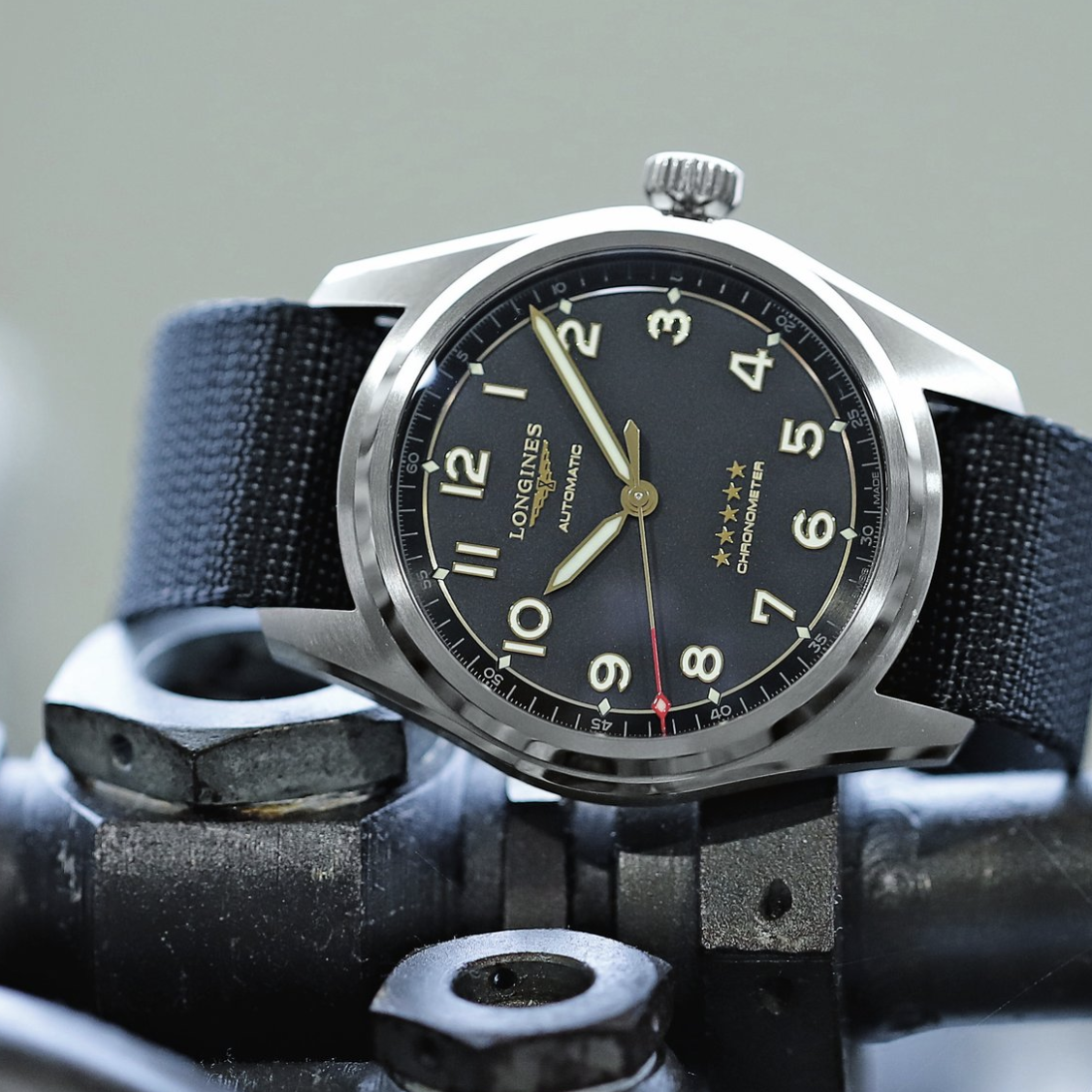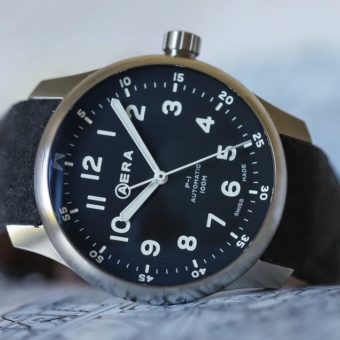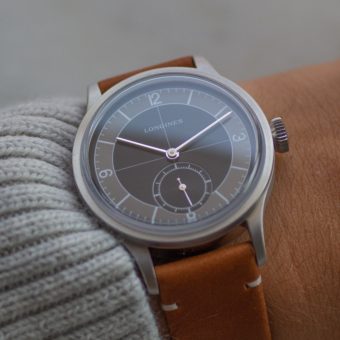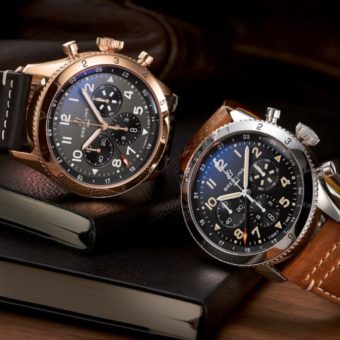This article was originally published in the March/April 2022 Issue of the WatchTime print magazine.
With the launch of the Spirit collection in 2020, Longines paid tribute to the many pioneering aviators of the early 20th century that had relied on its watches. Last year, the company with “the oldest trademark still in use in its original form,” introduced the first two Spirit watches in titanium, and, more importantly, sans date window. We took the 42-mm version (ref. L3.811.1.53.2) on a proverbial test flight.

In 2021, Longines introduced two versions of Spirit Titanium both as a “new step forward” and an “homage to the world of aviation,” thanks to their cases being forged from grade 5 titanium (an alloy of titanium, aluminum and vanadium), which is lighter and more durable than steel.
And an homage it indeed is: Due to both the metal’s increased availability and the need for more fuel-efficient, lightweight aircraft, titanium alloy-based metals have replaced many of the standard aluminum and steel components that have long been used in the aerospace industry. Historically, the use of titanium was often limited by the costs involved and therefore applied only for components exposed to high temperatures. On the legendary SR-71 “Blackbird” from Lockheed, which was designed for flight at over Mach 3, however, titanium was used almost entirely for the entire structure. And as it was revealed after the Strategic Reconnaissance (SR) plane’s retirement in 1998, the Skunk Works team was forced to source much of the needed material through Third World countries and bogus operations from none other than the USSR, which happened to be the major supplier of the ore during the Cold War. Things have obviously changed quite a bit since then, and today, the aerospace industry has become the largest industry to benefit from titanium’s excellent weight-to-strength ratio. The watch industry, on the other hand, obviously requires much smaller quantities of the material, and started working with titanium in the 1960s, with Citizen becoming the first watch manufacturer to unveil the world’s first serially produced titanium watch in 1970.

Longines offers the new Spirit Titanium in both 40-mm and 42-mm sizes, equipped with either a black NATO-style strap or an interchangeable titanium bracelet with the same satin-polished finish as the case. The Longines Spirit Titanium retails for $2,650 (40 mm) and $2,750 (42 mm) on the woven nylon strap with a titanium buckle, and for $2,950 (40 mm) and $3,050 (42 mm) on the titanium bracelet with triple-folding safety clasp and push-piece opening mechanism. For comparison, the stainless-steel versions with 40-mm cases (and date window on the dial) start at $2,150; the 42-mm chronographs retail for $3,100.

The Spirit collection, undoubtedly Longines’ most significant release in 2020, is drawing “traditional features from pilot’s watches and combin[ing] them with contemporary lines and codes.” Characteristically, all the watches feature a slightly oversized fluted crown, a pronounced, stepped bezel and a minute-scale flange, large Arabic hour numerals with diamond-shaped indexes, and big, luminous baton hands. The initial squadron comprised a trio of threehand-date models with a date window at 3 o’clock and a chronograph with a date window between 4 and 5 o’clock. To date, the collection has already been significantly expanded and currently consists of four dial colors (silver, black, blue or green) for the 40-mm automatic watch in stainless steel, three colors for the 42-mm chronograph (silver, black or blue), and comes on either a metal bracelet or leather strap.
The titanium version reviewed here (Ref. L3.811.1.53.2) comes on a black synthetic strap with easily “interchangeable system” and metal buckle. More importantly, the Spirit Titanium is the first watch in the Spirit collection that does not feature a date, opting instead for a much cleaner, symmetrical look. Surprisingly, Longines decided against renaming the L889.4 caliber after removing its date function.

Behind the caseback is the selfwinding L888.4 caliber, based on the ETA A31.L11 (itself a descendant of the relatively slim ETA 2892-A2), which is made exclusively for Longines. Thanks to its slightly reduced frequency of 25,200 vibrations per hour, the comparatively thin movement now offers a substantial 72-hour power reserve, a COSC chronometer certification and comes with an antimagnetic silicon balance spring.
With its new Spirit collection, Longines has not only managed to create an instant classic, the automatic three-hand models all qualify to be described as horological wingmen ideally suited for every occasion. While the date window on the stainless-steel watches could have been placed a little bit more harmoniously, the two no-date titanium versions consequently leave little to criticize in this aspect. The case finish found here is more than excellent, both for a watch in this price range as well as for the material it comes in, the anthracite dial, the length of the hands, the applied elements on the dial, the aligned caseback and the crown operation, which are an impressive indication of where Longines is heading. In short: the attention to detail is top notch, and so is the price-to-value ratio.

If one were to search hard for something to criticize, it might probably end up being the strap. The advantage of a NATO strap is — next to its look — the possibility to easily change it without requiring any tools. The disadvantage? A watch on a NATO strap usually wears a bit taller, the caseback is covered, and its metal surface might get polished over the years. Additionally, the strap potentially increases the length of the watch, because the strap is placed over the spring bars and sticks out a bit more than a traditional strap. For the Spirit Titanium, Longines chose a fixed NATO, representing a mix of both worlds, which means you still have the caseback and its engraving covered by the strap, a taller overall profile, and the strap sticks out a little bit on both sides, but you also have the spring bars (although of the quick-release type). In short, the same strap in a regular two-part configuration might have worked just as well. Visually, however, and also quality-wise, the black strap leaves little to wish for, and wearing comfort is as good as one would expect from the lightweight case material.
Overall, the Longines Spirit Titanium is a contender for the list of watches that simply tick all the boxes, if potential buyers don’t need a date display. Purists might criticize the use of the five stars on the dial of what used to be a flight instrument, but this element also increases the uniqueness of the design and works well with the surprisingly elegant applied numerals. In short, five stars for the Spirit Titanium.

The Longines Spirit Titanium retails for $2,750.
To learn more about Longines, click here, and to subscribe to the WatchTime print magazine, click here.






